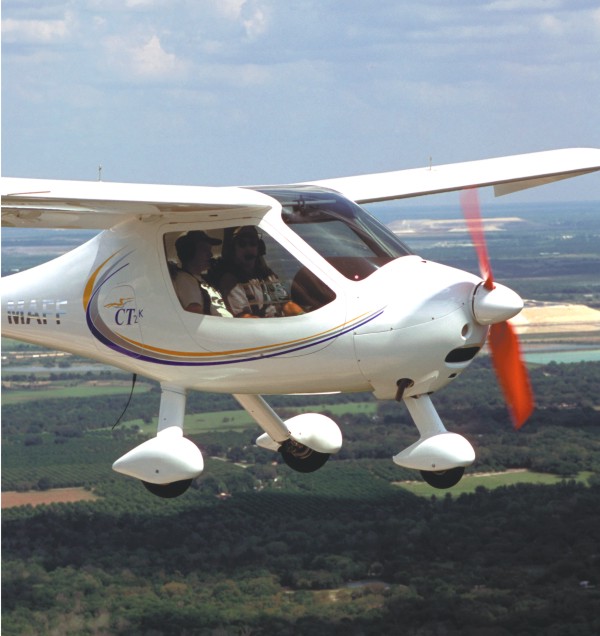
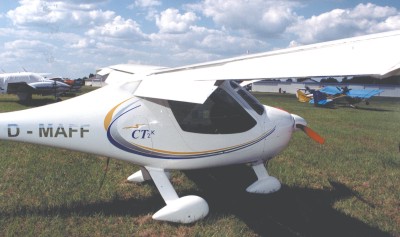
FLAPS & MORE – Note that when the CT’s flaps deploy, both ailerons also droop slightly to amplify the effect. Thanks to plenty of square area, the flaps remain effective down to stall speed.
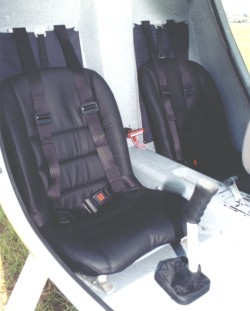
GORGEOUS SEATS – Very few light airplanes use leather seats, but I found them enjoyable. Four-point seat belts are standard and a ballistic parachute is an option. Note the pull handle between the two seat backs.
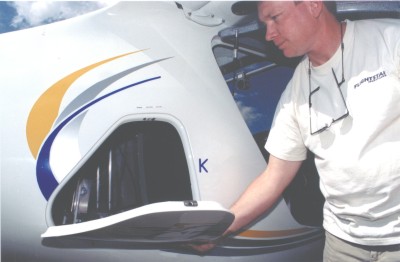
BAGGAGE COMPARTMENTS – Check-out pilot Jonathan Carter shows the baggage door opening. With a compartment on each side the CT can carry up to 110 pounds (though each flight should prepare a weight-and- balance calculation).

EMPENNAGE – Since the first CT I flew, the underside ventral fin was added to further improve directional stability at higher speeds. Using this tail, the CT exhibits light, enjoyable handling.
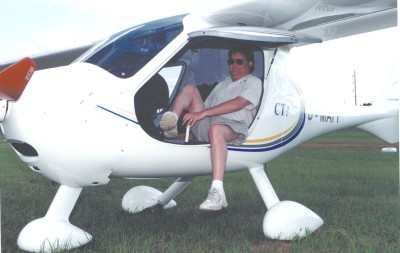
EASY ENTRY – Ultralight Flying! editor in chief Scott Wilcox agreed to demonstrate the CT entry. You merely sit down in the seat and swing in each leg. Scott properly shows a protective hold on the joystick during the procedure.

CONSOLE CONTROLS – Nicely organized in the center of the two occupants are, from right to left, hand brake to both main wheels, throttle with friction lock, choke lever (without a handle to lessen miscontrol) and trim. Note the fuel cutoff, the handle of which covers the key switch so you cannot take off with the fuel lever in the shut-off position.

CANTILEVER & CARTER – Jonathan Carter smiles with satisfaction in his flying of the CT for importer Flightstar Sportplanes. Note the full cantilevered wings for this design.

LARGE PANEL – Though this CT hasn’t used all the space, plenty of room is available for radios or additional instruments. Using the EIS, the CT saved panel space yielding this uncluttered appearance.

SMOOTH & FIXED – Even with its legs hanging out, the CT offers a sleek shape for the wind to pass. The clean fiberglass work is done in the Ukraine from a German design.

UPPER CABIN – The CT cockpit is roomy and airy. As this view indicates, it is also nicely finished throughout in an easily cleaned interior that doesn’t add weight with interior panels or carpeting.
In the fall of ’01, I wrote in Ultralight Flying!, “The CT is the tip of an iceberg, in my opinion.” When I flew that first CT in the USA, few Yankees had seen the aircraft. I felt the German design represented the beginning of a flow of European aircraft coming to America. What a difference a couple of years make!
Thanks to adept and steady promotion, Americans may best identify the coming breed of proposed Light-Sport Aircraft by pointing to the Flight Design CT2K. While this means no disrespect to trikes, tube-and-rag ultralights, or powered parachutes, the CT’s unusual, smoothly-contoured shape is now well known to many Americans. Though the brand is fabricated in the Ukraine and assembled in Germany, it crosses the Atlantic as a prototypical candidate for FAA’s proposed Light-Sport Aircraft category.
Rollison Light Sport Aircraft imported the first U.S.-based CT I flew. The design is now brought in by Flightstar Sportplanes and HPower HKS engine honcho Tom Peghiny. Flightstars and CTs display well together at airshows, enough so that brand-new FAA Administrator Marion Blakey chose to fly with Peghiny in the CT at AirVenture ’03.
When FAA drops the go flag and launches Light-Sport Aircraft into the skies above America, one of the first to gain approval and attract customers will surely be the CT, short for “Composite Two-seater.”
This is my third time to fly the CT, including one time before it was the British-certification-inspired CT2K. I flew in the spring of ’03 with Jonathan Carter, a highly qualified pilot who often helps Flightstar Sportplanes at airshows.
Why Flightstar Imports the CT
Many Ultralight Flying! readers know Tom Peghiny is the president of Flightstar Sportplanes. His Flightstars have sold around 1,000 units and the business continues steadily. So, why complicate matters with an imported aircraft like the CT? Tom tells the story.
“I had been approached by Matthias Betch, [Managing Director] of Flight Design, back in ’98 to represent the CT in the U.S. At that time FAA and EAA had been promoting how easy it was to certify an aircraft under Primary Category. As it turned out, Primary Category wasn’t really right for certifying aircraft for our sport. We thought we could use the German BFU [ultralight regulation] certificate under Primary Aircraft but this turned out to be an incorrect assumption.
“Later, AirCam developer and Rotax guru Phil Lockwood encouraged me to check out the plane then represented by Rob Rollison. Rob and I are good friends and I felt if he were interested there was a good reason. Lockwood is experienced in aircraft design and he liked the packaging of the plane and thought it was the most modern type he’d seen.
“The fact that a reputable company, England’s premier trike maker Pegasus Aviation, was their distributor in the UK and had certified it to the British BCAR Chapter S airworthiness standard meant a lot as well. The British require periodic inspections of the production facility and their flight test standard in particular is very stringent.
“Also, the plane complies with the European noise standards, which is important to me personally. If our sport is to grow more popular and operate near cities and towns we have to make our planes in the U.S. quieter than they are now.
“I went to Ukraine to the fabrication factory in June ’03 to do a preliminary quality control inspection. I followed the Pegasus inspection paperwork and also used the latest draft of the ASTM quality control standard to evaluate the Ukraine plant.
“The factory itself is rustic but the engineering staff at Flight Design Ukraine is young and motivated. The system they use, in my opinion, is valid when comparing it to the requirements. They have a very large staff including 8 engineers. The whole plane is defined in CATIA software, which is the same used by Boeing and Airbus.”
Peghiny encourages interested pilots to go to the company Website (www.flyflightstar.com) where you can download assembly and parts manual PDF files for the CT.
The carbon fiber and Kevlar construction yields a lighter and very strong airframe, which allows a larger useful load, reports the factory. Keeping weight down allows 34 gallons of fuel to be carried for a longer range.
Locating the fuel tanks in the wings improves crashworthiness by keeping fuel away from the plane’s occupants. It also leaves the rear fuselage open for baggage and proper installation of the optional ballistic parachute system.
Delightful and Quiet
This latest CT2K was very quiet to those on the ground. This is an effect of European regulations that demand low noise. Those regs specify no more than 55 db at 150 meters (492 feet). This is the noise level of ordinary conversation, and heard from 500 feet away, the CT will not disturb any but the most sensitive neighbors.
Its exterior is sleek, and the plane is surprisingly roomy inside. All but the largest Americans should fit well and for average-size persons, the CT is positively cavernous compared to many other light aircraft or ultralights.
As you sit in the pilot’s seat, you are surrounded by well-designed features that have changed to the better since my first CT flight in ’98.
In front of you is a large panel that can hold virtually every goody you might want. In the aircraft I evaluated, this panel was clean and neat with only an ASI, altimeter, turn coordination ball, flap indicator, and electronic info system. You don’t need any more but those who want more navigation gear, radios, or info systems have room for it. Of course, you still must keep the CT within the proposed 1,232-pound limit of Light-Sport Aircraft. Fortunately, you have plenty of room. The CT carries more than it weighs.
Flaps in most ultralights and light aircraft are typically moved mechanically. A lever or handle deploys and retracts. Some have detent positions to help you know what you’ve deployed; others mark the flap itself and you check visually. The CT2K has an electric system with a clearly visible panel lighting system that shows you their position. The lights come on gradually and you must look to see progress. Some complain this method distracts you during landing and that a system that allows you to merely feel your way to a notch or two is better.
Though I never once needed to use trim, it operates through the servo tab for the stabilator that extends on both sides of the rudder. Most aircraft use a trim surface only on one side.
A slide-latch feature allows the hand brake lever to secure the brakes. Simply pulling back on the brake lever releases the parking brake.
One rather unusual but very clever feature is a fuel valve with a long handle. When you shut off fuel, the handle sits over the electric start ignition switch in such a way that you cannot take off with the fuel valve in the “off” position.
The CT2K doors do not open in flight. While Carter told me that he had discussed with Peghiny the result of an in-flight opening, the situation is unlikely as the doors have a solid mechanism to keep them shut after entry. A sliding latch secures the door and, since it sits at your elbow, operators will want to observe its position after bumping it.
The CT is actually a four-door airplane. In addition to the two cockpit doors, the design has a very useful baggage area aft of the cabin. The baggage area doors use a pull knob inside the aircraft, which releases a latch. You then lift up on the door to pull a couple of pins out of their detent positions on the lower lip, which subsequently allows the doors to open widely. They are secured with lanyards to prevent dropping as they are no longer attached to the aircraft by hinges or other means. A plastic shield was fitted inside to prevent baggage area contents from conflicting with the control linkages also in this area. What continues to surprise me is that you can put 55 pounds of luggage in each side for a total of 110 pounds of baggage. Of course, you must assure doing so won’t put your center of gravity out of envelope, but Flight Design says the CT can fly with just about anything you put inside.
With a red, wide-blade prop, flight into some lighting conditions produced a red haze out front. It wasn’t a problem but I noticed it. Though the red prop looks sharp on the ground, I think I’d prefer black or gray. I don’t want any obstruction in visibility.
Fire Up and Fly
The CT is nicely equipped. The creativity of airplane designers never fails to impress me. I love the way this aircraft is laid out and how it functions for the pilot. But each pilot is different.
My friend and fellow aircraft reviewer, Dave Higdon, didn’t care for the way the brakes worked. He’s a general aviation pilot and usually focuses on those aircraft so he prefers toe brakes even if they come at the expense of a few extra pounds of hardware.
Conversely, I found the hand brake quite useful although you must remove a hand from other activities in order to exert braking. In some situations you might run out of hands, I suppose, though braking is usually not so urgent. You also use one hand on the throttle and the same hand for the brake on the CT and I don’t see how you’d ever use both at once. In practice, the hand brake was quite effective in slowing/stopping power.
My approaches with Carter observing were done at 60 mph but 50 would be better after you become more familiar with the design. Once so experienced, the slippery machine could be landed even slower, I believe. Such experience would allow you to execute short-field landings. Until then, you’ll want to land on longer runways.
If I reacted as though I were flying an ultralight, I tended to turn from base to final too soon, leaving me too high in an aircraft that doesn’t want to descend. Using typical ultralight technique in this aircraft won’t get you down on a short runway. You must plan ahead better when flying the CT2K, which boasts an engine-off glide of 16:1.
Putting the flaps down to 30° helps round out your flare. At 40° of flaps I noted significantly more drag so that even with the nose angled sharply down, we still did not tend to accelerate past 50 mph without further pitch control. Therefore, proper use of the flaps will help for short- or soft-field operations.
Visibility was very good forward, up and laterally, but as I made a right- hand pattern, flying from the left seat, I had to ask for Carter’s help to look back at the runway. In left-hand patterns – assuming you’re flying from the left seat – aft visibility to the runway is much better.
The CT slipped quite well, but on exiting the slip, the CT tended to accelerate. Carter said he has noticed this on Cessnas as well. Probably this is simply a normal return to flight, but it may be enhanced by a smooth fuselage shape that actually produces some aerodynamic effect when deeply slipped.
The flaps move extremely slowly. You must plan ahead for their use due to a perceptible delay in their deployment. Ultralight pilots must keep in mind that the CT isn’t an ultralight by American standards and thereby should not be flown like one.
All my landings were good, though both Carter and I wondered if my full-stall-landing technique brought the tail too close to the ground. The CT has added some substantial structure under the tail feathers but it has no skid. (The first CT I flew in ’98 did not have the vertical area seen on the CT2K.)
Zipping About in a CT2K
I found it a little tricky to keep the ball centered when doing Dutch rolls or other faster control exercises. However, the CT is better behaved than older Kitfoxes, which slap the ball from side to side on the slightest provocation. Carter actually suspected the ball was sticking a bit. Perhaps so. A Cessna 172 Hawk XP I often fly for BRS had a similar problem where the ball mysteriously froze up inside its curved glass tube.
In my Dutch rolls at medium speeds, I had to use rudder pedals heavily to keep the ball in the center. Deflection didn’t have to be full, but it was close.
The joystick works very nicely. It is comfortable to reach. Roll rates are quite brisk and stick pressures are quite light while still offering some feedback. Carter indicated that the CT2K has some spring dampening to keep controls from being too fast. I can understand this change as the very first CT I flew in ’98 had handling that was almost too light and quick for comfort.
Steep turns were quite easy to do, even with low power. Practicing these 45°-banked circles again showed me how clean this aircraft is. It slips through the air so easily.
Although you have to work rather significantly to get the CT down, the 16:1 glide becomes a safety feature should you have an engine-out landing. Cleanliness of the CT helps it reduce altitude loss with the throttle retarded or the engine at idle.
While doing the photo shoot for the cover of Ultralight Flying! we were running 60 mph with the engine only revving in the high 3,000- to low 4,000-rpm range. The day had some thermal lift, but I was still amazed at how the CT does not want to come down from the sky.
After tuning by the Flight Design engineers the CT2K will fly precisely at the 132-mph speed limit proposed by FAA for Light-Sport Aircraft. A propeller well matched to the standard 81-hp Rotax 912 engine is the secret (the CT flown for this evaluation was equipped with a 100-hp Rotax 912S). With a different prop, the ’98 CT I flew raced along closer to 150 mph. This suggests that some owners might reprop the CT for higher cruise speeds, but of course, doing so would invalidate the certification of the design.
Importer Peghiny says, “The cantilevered wing with a sailplane airfoil and camber-changing flaps give the [CT] a wide speed range while using less power. That the plane is quite fast people know, but what impresses me more is its slow speed handling and short-field performance.” I discovered the same feeling. The CT flew as nicely low over the fields as slower ultralights.
Back at altitude my trials of slow flight got the CT down close to 30 mph, though the ASI is surely not accurate at that speed. Although we were hanging at the edge of stall, the CT still offered good control qualities.
These slow speed impressions illustrate that you can approach for landing at 50 mph – in moderate wind conditions – which will help set down the slippery airplane on a shorter runway.
In every stall performed, I found a distinct break. It isn’t threatening, but the CT always tended to fall toward the left wing. I wasn’t disturbed by this though a brand-new pilot might be. Then again, this isn’t an airplane for a beginner.
The combination of the flat glide and the light composite structure might not make flight training the best role for the CT as repairs could be expensive. Pilots need to understand, the CT is a high-performance aircraft, says Peghiny. It is used for flight training in Europe, but it requires a different technique due to its glide ratio.
Peghiny says of his demonstrator CT2K, “Our plane is equipped just right for cross-country flying. We have a Garmin GPS-Com, a Garmin Mode C transponder, an electric Artificial Horizon, and turn and bank. We also chose a BRS parachute for ours as [the plane is] certified with it in Germany, and I’m used to having them on my planes.”
Peghiny and Flightstar have long supported the parachutes-for-airplanes concept and this notion has broad appeal. When Peghiny gave his young son Jeff an aerobatic ride in a Citabria as a present in the fall of ’03, he was cool with getting upside-down until he went to put the parachute on. “Why am I wearing the chute and not the plane? What a dumb idea, dad,” Jeff commented.
You and a CT2K?
As we begin to greet Light-Sport Aircraft to the ultralight and light airplane community, it is clear that the CT2K may be one of your higher-end choices. With the value of the euro – Europe’s new continent-wide currency – and its recent rise against the dollar, the CT’s price has risen to around $70,500 for the deluxe CT-Cruiser model. A CT-Sport model, still very well equipped, sells for $64,500 (check with the importer for the last price quote; it changes regularly). With either model though, that’s a lot of money. [NOTE: In mid-2006, the rising euro to dollar relationship has priced CT at $92,900…though such a dollar price increase is also affecting other LSA imported from Europe.] Is it worth it?
Peghiny explains, “The reasons we chose to become the North American distributor for Flight Design’s fixed-wing products are simple. The CT is the most advanced product in this marketplace. Aerodynamically, structurally, and even in ergonomic design, the CT is really unique.”
Despite the purchase price, the CT is a decent value. The price tag is far lower than any general aviation 2-seater certified under FAR Part 23, tens of thousands less. And it operates at similar (or even greater) speeds while consuming far less fuel.
Peghiny recounts an experience of flying the CT2K from Flightstar’s home base in Connecticut to Florida. “The 100-hp Rotax 912S is very frugal with fuel. I flew the plane to Sun ‘n Fun ’03 and back by myself and was really impressed with the comfort and the performance. On the way down I flew from Ellington, Connecticut, to central North Carolina before stopping for fuel, and then went all the rest of the way to Lakeland, Florida on the next leg.” Indeed, the CT has a range of 1,000 statute miles non-stop.
The CT2K may be the “poster boy” Light-Sport Aircraft and it can deliver some real flying fun. Since it can fly slowly quite well and still zip along at 132 mph, the range of utility is wider than many other ultralight or light aircraft.
Is it for you? Well, maybe you, like FAA boss Marion Blakey, ought to get a demonstration flight and see for yourself. As any new rule may arrives, so may quite a number of CT2Ks and you may not want to be left behind.
| Seating | 2, side-by-side |
| Empty weight | 580 pounds |
| Gross weight | 1,232 pounds |
| Wingspan | 30.5 feet |
| Wing area | 116 square feet |
| Wing loading | 10.6 pounds per square foot |
| Length | 20.5 feet |
| Height | 7 feet |
| Fuel Capacity | 34 gallons |
| Kit type | Fully assembled |
| Build time | None, or assembly from shipping only |
| Standard engine | Rotax 912 |
| Power | 80 hp at 5,500 rpm |
| Power loading | 15.4 pounds per hp |
| Cruise speed | 132 mph |
| Economy Cruise | 4.5 gph |
| Never exceed speed | 192 mph |
| Rate of climb at gross | 1,000 fpm |
| Takeoff distance at gross | 300 feet |
| Landing distance at gross | 450 feet |
| Notes: | *Wing loading with the 912S (100 hp) engine is 12.3 pounds/square foot. |
| Standard Features | 80-hp Rotax 912, quickly removed wings, 4-point belts, 3-color paint scheme, 2 baggage compartments, ASI, altimeter, tach, oil gauges, CHT, and numerous amenities and appointments suiting a $60,000 aircraft. |
| Options | 100-hp Rotax 912S, leather seats, additional instruments and avionics, BRS emergency parachute system, skis, Full Lotus floats, special paint and graphics. |
| Construction | Fiberglass airframe reinforced with carbon fiber. Manufactured in Eastern Europe for a German-owned company; distributed by U.S.-owned Rollison Airplane Company. |
Design
Cosmetic appearance, structural integrity, achievement of design goals, effectiveness of aerodynamics, ergonomics.
Pros – Sleek, cantilevered design not seen in ultralight circles (more similar to U.S. homebuilts). Excellent combination of features and attributes: roomy, speedy, well appointed for American market. Built around 80-hp Rotax 912 engine.
Cons – Fiberglass and carbon repairs are said to be not difficult, but experience is needed with these materials. At present, the test CT is the only one operating in America.
Systems
Subsystems available to pilot such as: Flaps; Fuel sources; Electric start; In-air restart; Brakes; Engine controls; Navigations; Radio; (items covered may be optional).
Pros – Test CT was loaded with extras. Flaps have usual down positions but also up or reflex positions which can be used to enhance cruise performance. Electric start standard with Rotax 912s. Fuel capacity is large. Hydraulic brakes are via lever; work well.
Cons – The CT isn’t missing any systems you probably want, but all more complex aircraft require more familiarity to handle competently. Engine accessible only after cowl removal. Brakes don’t assist ground steering.
Cockpit/Cabin
Instrumentation; Ergonomics of controls; Creature comforts; (items covered may be optional).
Pros – Huge roomy cabin 49 inches wide. Interior compartments accessible in flight. Wide doors for easy entry/exit. Comfortable, supportive seats with 4-point belts. Seats adjust both bottom and back rest. Panel easily reached.
Cons – I struggled to unlatch the gull-wing door for closing when securely belted. Seemed somewhat noisier than another European 912-powered CT I flew in France. No other negatives to this wonderful cabin.
Ground Handling
Taxi visibility; Steering; Turn radius; Shock absorption; Stance/Stability; Braking.
Pros – Very straightforward handling for anyone used to conventional tri-gear operation. Brakes were quite effective. Visibility was very broad (except upward). Large ground clearance. Quite precise to taxi.
Cons – Rather stiff suspension (mostly noticed on turf runway). No aft window or visibility.
Takeoff/Landing
Qualities; Efficiency; Ease; Comparative values.
Pros – Responsive controls allow normal crosswind operation. Glide seemed quite strong, an asset in an engine-loss situation. Flaps help control glide path and slips are reasonably effective. Large ground clearance will help if you must land off-field.
Cons – In France my landing was good. At shorter airstrips you’ll need practice to handle the the CT’s long glide; you must plan approaches well. Takeoff roll is long (compared to ultralights), thanks to smaller wing and higher weight.
Control
Quality and quantity for: Coordination; Authority; Pressures; Response; and Coupling.
Pros – Very light and responsive handling. Dutch roll coordination exercises went well almost immediately (though always keeping the ball centered will take some experience). Well balanced controls. Precision turns to heading were easy.
Cons – Pitch is light enough that some pilots may not feel comfortable. Coordination will take some time to optimize. Adverse yaw is significant.
Performance
Climb; Glide; Sink; Cruise/stall/max speeds; Endurance; Range; Maneuverability.
Pros – Very speedy design. Even with an incorrect prop, I saw speeds of more than 140 mph (though for U.S. market, the CT will be propped down). U.S. model with IvoProp propeller didn’t exceed 132 mph, per GPS runs. Slows down under 40 mph.
Cons – Climb not as strong as expected, perhaps optimized for European high-cruise speed desires.
Stability
Stall recovery and characteristics; Dampening; Spiral stability; Adverse yaw qualities.
Pros – Fitting both German and English certification systems, the CT has normal stall response, longitudinal response, and throttle response – a benefit of such programs. Four-point seat belts are standard.
Cons – Slippery airplane that may be more than some pilots want. Fitted with a parachute, though with the activating handle awkwardly located in case of emergency (see article).
Overall
Addresses the questions: “Will a buyer get what he/she expects to buy, and did the designer/builder achieve the chosen goal?”
Pros – The CT has German certification, and thanks to Pegasus, approval under the tough English system. Though $60,000 is a lot of money, the CT is a well equipped model for far less than a certified general aviation aircraft or many homebuilts.
Cons – CT kits are currently unavailable (European sales allow fully built models). Company and plane are not well known in the U.S., which could affect resale ability.


What is the cost? Are there used ones for sale?
By all means, contact Airtime Aviation for price information.